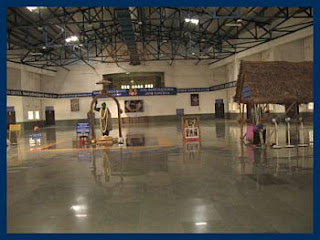
The next photograph is of the outside of the house in which Sri Tinnai Swami lived for over 40 years.

The below is of Subhalakshmi Amma, widow of the late C.P. Nathan, in whose home the atma-jnani Sri Tinnai Swami lived on a verandah masonry bench (tinnai) for over 40 years; attaining samadhi on Deepam Day, 7th December 2003. Subhalakshmi (who now lives with her daughter-in-law, Radha, in the Sadhu Om colony), for most of her life was in the blessed position of being able to serve and cook for two atma-jnanis; Sri Tinnai Swami and Sri Sadhu Om.
When I met Subbhalakshmi Amma this week, she told me of some of her experiences at Tiruvannamalai and memories of the saints living in her compound. She also recalled that the first time she came to Tiruvannamalai, with her husband C.P. Nathan, to take blessings from Ramana Maharshi was in 1946. At that time Subbhalakshmi was just 20 years old, and did not speak to Bhagavan, in its place she bowed to him.

In 1947 the C.P. Nathan family were able to make a permanent home a short distance south of Ramana Ashram, and were then able to offer a home to both Sri Tinnai Swami and in the family's adjacent home, Sri Sadhu Om. Subhalakshmi's two sons Arunachala Ramana and Amritalingam (and their wives) were also committed to the service of the saints living in their home. As well as serving the two saints, Subhalakshmi Amma has also been fortunate to be able to cook for many of the saints who occasionally visited her compound including such luminiaries as Yogi Ramsuratkumar and Sri Muruganar.
Subhalakshmi's daughter Radha (widow of Subhalakshmi's youngest son Arunachala Ramana) maintains the tradition of cooking for sadhus and pilgrims in her home at Sadhu Om and at her sattwic kitchen, Tamil food is served three times a day to visiting pilgrims and sadhakas.
The below photograph is of the pretty and serenely peaceful Sadhu Om Colony.

The current Sadhu Om Colony now comprises the samadhis of both Sri Sadhu Om and Sri Tinnai Swami. The below photograph is of the samadhi of Sri Sadhu Om.

And below is a photograph of the samadhi of Sri Tinnai Swami. As in life both saints lived in two adjacent homes of the same family, in death (samadhi) the tombs of both great atma-jnanis are positioned next door to one another.

The colony is also comprised of several beautiful cottages maintained by the Subhalakshmi family and occupied by visiting sadhakas and pilgrims.

"During the many years that he lived on their tinnai, C.P. Nathan, and his family were blessed with the good fortune of providing him with the little food, clothing and shelter that his body required, and in the early years in spite of their then state of poverty they performed such service not only to him but also to Sri Sadhu Om and other sadhus and devotees of Sri Bhagavan. Sometimes they even had to sell their cooking vessels in order to purchase provision to feed visiting devotees. All of us who had the good fortune to know Sri Tinnai Swami will be very grateful in particular to Mrs. C.P. Nathan, who in spite of many hardship serviced him with great devotion in every way she could especially providing him food, as she did till the end in spite of her advanced age and physical weakness."
















































